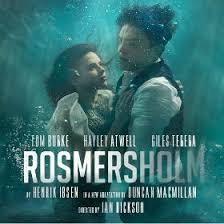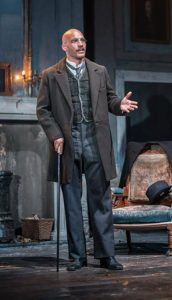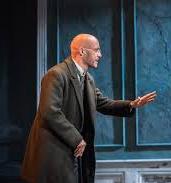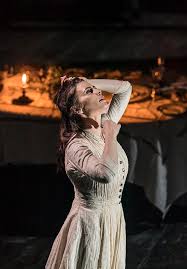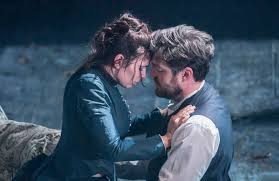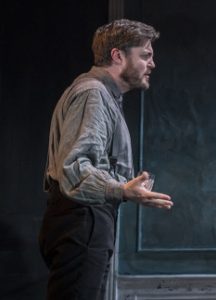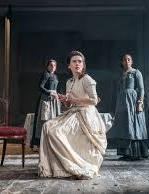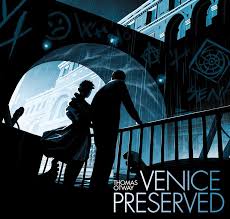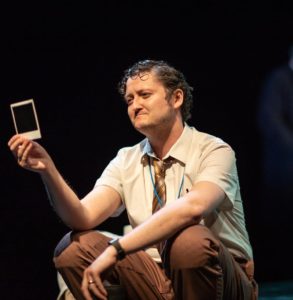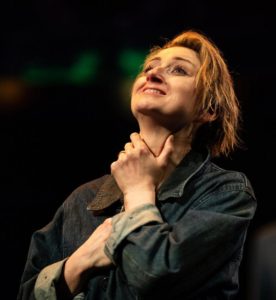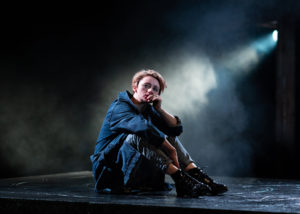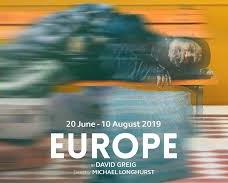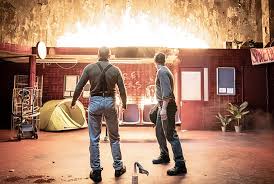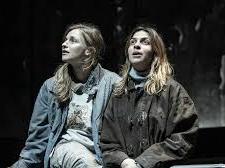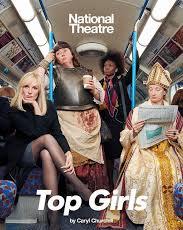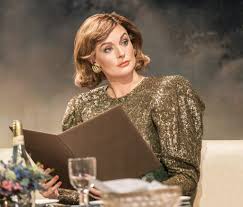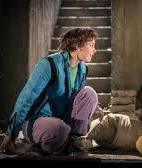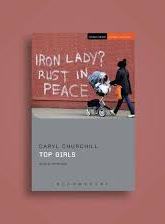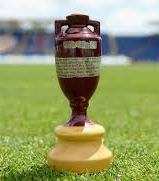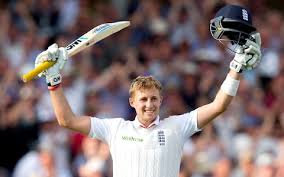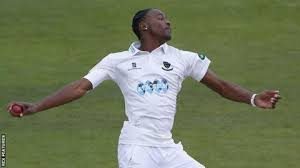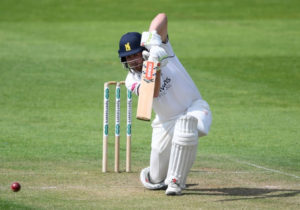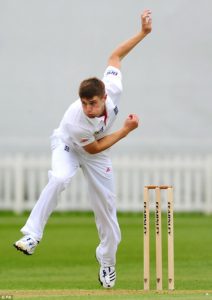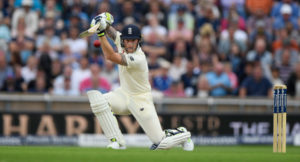Rosmersholm
29 July 2019
When John was here a few days ago, we went to see a production of Ibsen’s rarely performed play Rosmersholm, at the Duke of York’s Theatre in the West End. My friend David Thomas came with us on this occasion.
The publicity material for the show proclaims it to be a masterpiece, but that is an exaggeration. Rosmersholm is a mature work, written after A Doll’s House and Ghosts but before Hedda Gabler, and in it Ibsen clearly attempts to combine political and personal elements. But I think its various themes are too densely packed for any of them to emerge at all clearly, and I also had some difficulty believing in the two principal characters, Rebecca West (played here by Hayley Atwell) and the ex-pastor Rosmer (Tom Burke). Even by Ibsen’s standards they seem over-burdened with guilt over past events whose full detail we have to infer for ourselves.
West originally joined Rosmer’s household apparently as a companion for his wife, but has stayed on after the wife killed herself. The circumstances of that suicide form one thread of the plot. Did she do so because of her own failure to produce an heir to the Rosmer estate, or because of Rosmer’s new relationship with West? Was West complicit in the suicide, and to what degree?
A second theme is whether Rosmer can be brought to support one side or another in a forthcoming election. The long-established Rosmer family is influential locally and as the community’s ex-pastor Rosmer himself is highly respected. The conservative interest is represented by Kroll (played by Giles Terera), editor of the local nerwspaper, who is also Rosmer’s late wife’s brother.
The radical interest is represented by Mortensgaard (Jake Fairbrother), proprietor of another newspaper, who was shunned by the community after a previous indiscretion. Kroll wants to bring Rosmer over to his side by any means necessary: persuasion, manipulation, blackmail. Initially, so does Mortensgaard, but when he discovers that Rosmer has lost his faith (another strand in the plot), he determines to use this as a pre-emptive strike against him.
The third element in this brew is the relationship between Rosmer and West. It appears that they are in love; but are they lovers? and if so, when did the affair start – before or after his wife’s death? Since seeing the play I have read a number of different commentaries, and it appears that even Ibsen experts are divided on this subject. Ibsen must have intended to leave it obscure. But in any event both characters clearly feel a mix of love and guilt which has paralysed their ability to move on with their lives.
Fourth, there is the character of West herself. She is clearly a New Woman – educated, independent, well able to think and stand up for herself. The British writer Dame Cicily Isabel Fairfield took Rebecca West as her pseudonym in honour of Ibsen’s character. But such a person would have been scandalous in the community depicted in Rosmersholm, and indeed for many of Ibsen’s audiences. She holds Radical views and at one point confronts Kroll, who wishes to break her influence over Rosmer. He cruelly reveals a secret about her parentage, causing West much anguish (and incidentally revealing himself as a villain).
This is a curious incident. You can see it shakes West’s sense of herself: she is not who she thought she was. (At least one commentator suggests she is being told that she has unknowingly committed incest with her own father; but I think that goes beyond the text.) Under pressure from Kroll, she is brought to admit that she joined the Rosmer household with the specific intention of shaking Rosmer out of the unthinking conventionality which he had inherited with the house and family name. She has succeeded, but in doing so has compromised her self by the part she may have played in Rosmer’’s wife’s suicide and by falling in love with him herself.
But this only leaves more mystery. How did West pick out Rosmer in the first place? And how does she come to be part of the household? Ibsen leaves these questions unanswered. And there are others. The fact that Kroll is Rosmer’s brother-in-law seems like a piece of plot that should lead somewhere, but doesn’t. Even Morgensgaard’s back story looks as though it is going to be significant but is never developed. There are enough ideas and plot points here for another full-length play that we never see.
It all makes for a heady brew (and there are other complications, as well as a sub-plot involving a former tutor of Rosmer who turns up unexpectedly at the door), but I don’t think Ibsen is entirely successful in finding a resolution. In the original version of the play, Rosmer and West, each consumed by their own guilt, end up committing suicide together in the mill-race, as his wife had previously done. In this production the ending is more ambiguous, as the couple appear simply to be abandoning Rosmersholm forever, but then there is a crashing noise and we are left to infer their fate. Perhaps Duncan Macmillan, who adapted Ibsen’s original play for this production, feels that the original ending is just a bit too melodramatic for modern tastes. If so, I’m not sure this was much of an improvement.
We are clearly meant to sympathise with Rosmer and West, and to despise Kroll and Mortensgaard. (David surprised me by saying that the character with whom he has most sympathy is Kroll; on political grounds, I think. I’m pretty sure that’s a minority view, and not at all what Ibsen intended. To my mind, and most others’, Kroll’s behaviour is despicable whatever his political goals.) It is true, though, that at least the newspapermen-politicians know what they want and are resolved to get it if they can, while the couple are unable to find any way forward for themselves. And while K and M are little more than two-dimensional cut-outs, the two principals are difficult to resolve into believable characters at all. It is as if their very apparent self-doubts have infected our ability to believe in them.
Rosmer is played here by Tom Burke. He is very good: it must be hard to portray such a terminally indecisive, conflicted, character, since there is so little to get hold of, but he at least makes us see the conflict within him. He is, or has become, an idealist who rejects convention and religion but is not a revolutionary, so can align with neither K nor M. I wonder whether Rosmer’s character can be better interpreted with the aid of a little more Norwegian history from the period. During the second half of the nineteenth century, Norway transformed from monarchy to Parliamentary democracy, with a wide (male) suffrage. This must have been associated with major social change and perhaps in that context Rosmer’s rejection of both sides would make more than abstract sense.
West is played by Hayley Atwell, whom John and I saw only a few months ago in Measure for Measure at the Donmar. Ibsen himself said to the actress who created the role that West was a complex character who would be difficult to portray. Atwell’s is in many ways a brilliant performance, as we see her initial self-confidence turn brittle and crumble. I know of no young(ish) actress (she is 37) better able to convey character by movement and gesture alone. But her voice projection here isn’t perfect, and I wonder if she and her director Ian Rickson, who really should have resolved this issue, have been caught out by the depth of the theatre’s proscenium stage.
I have spent much longer than usual preparing this blog while I work through my own ideas about the play. Does this, after all, suggest that it may be a masterpiece? Insofar as Rosmersholm has an overarching theme perhaps it is the interaction of the political and the personal. If we fail to engage in politics we are condemned to ineffectiveness; if we do engage we put at risk some part of our selves. In this adaptation two different characters apologise with the words “It isn’t personal, it’s politics,” obviously a free adaptation by Macmillan but which elicits a wry acknowledgement from the audience. It helps explain why the producers chose to do this play at this time. But if this is what Ibsen means to convey it emerges only with effort from a thicket of his other preoccupations – the role of women in society, the power of the past to influence us, the weight of real or imagined guilt – all tangled together without proper resolution. Intriguing, certainly; masterpiece, I think not.
——————–
Venice Preserved
28 July 2019
Janet and Chris, John and I went yesterday to Stratford-on-Avon for the RSC’s current production of Thomas Otway’s Venice Preserved. I was the only one among us who had seen the play previously, and that was so long ago that I cannot remember any of the details.
Otway was a Restoration dramatist. He died in poverty at the age of 33, leaving behind him half a dozen plays of which VP alone still has a place in the repertory. We mostly think of Restoration drama as comedy – I wrote about Vanbrugh’s The Provok’d Wife only a few weeks ago. But VP is a tragedy. The plot concerns an attempt to assassinate the members of the Venetian Senate en masse, but its two male protagonists, Jaffeir and Pierre, are motivated not by political feeling but by personal resentments against individual senators. This isn’t a re-run of Julius Caesar.
Before the show we were a little apprehensive about what we would be seeing. The Press reviews have been unusually mixed – Michael Billington in the Guardian is appreciative, Dominic Cavendish in the Telegraph damning – and the various blogs I have read are similarly divided. The director, Prasanna Puwanarajah, is new to the RSC and the programme notes suggest that he has brought a strong cyberpunk vibe to the production. In several recent productions the RSC’s directors have overlaid their own ideas on plays which should have been allowed to speak for themselves. Would this be another such?
In fact, no. The production is in modern dress, scarcely revolutionary. Some of the characters carry revolvers or machine pistols, but there are no awkward dissonances with text speaking of swords and shields, as you sometimes get in modern-dress Shakespeare. All the on-stage violence is done with knives or fists.
Use is made of projections on a large black screen above the stage, but they were too blurry and dark (and anyway out of our eyeline from the side stalls, where we were seated) to worry us much. There is one flashing-neon scene change, with pulsing music and posing dancers, early on which is no doubt intended to suggest the decadence of this Venice; but it does not set the tone for what follows. (The decadence is sufficiently displayed before the play even starts. Heavy drips of water fall intermittently from the roof into a grid centre-stage. This Venice is decaying, no doubt of it.) On the other hand, very effective use is made of pink laser light shining through thin haze to demarcate a cell in which Jaffeir’s wife Belvidera is held hostage: a clever, and simple, piece of design.
The only really serious and persistent intrusion is the music, mostly a single electric guitar, continuing in the background. Most of the time the guitarist remains in the wings, but at one point he actually appears backstage, an unwanted and unexplained presence. This isn’t the first time recently at a theatre that we have had to endure background music, as if the director, learning the wrong lesson from movies and TV, has failed to trust his actors and script to deliver the necessary drama without musical help. It is sad to see the RSC falling for this.
So much for the production; what about the play? Otway’s original is apparently four hours long, and it has been heavily pruned back to two and a half hours here. I’ve no doubt some editing was well justified. Otway’s verse, though serviceable enough (Cavendish is unnecessarily rude about it), rarely catches fire: it is character and situation which have to hold the audience’s attention. Unfortunately the cuts have left some big holes in the plot. Crucially, we never learn how Pierre and Jaffeir, whose re-encounter at the start of the play sets the whole plot in motion, came to know one another. This matters because Jaffeir is clearly dominated by his friend, in awe of him and more than a little in love. The production recognises, without over-emphasising, the strong homoerotic element in their relationship, though the feeling does seem to go mostly one way. This Pierre is much more exploitative than loving.
Otway does seem obsessed with unusual psychosexual relationships. Another plot strand concerns Pierre’s relationship with his ex-mistress Aquilena (played by Natalie Dew) who, in his absence, has supported herself by acting as S&M dominatrix to an elderly senator, Antonio (John Hopkinson). There is a grotesque scene in which Antonio uses baby talk and play-acts as various animals while Aquilena, fully kitted out with S&M gear, spurns him. Dew was also in The Provok’d Wife and here, as there, provides a characterful counterpoint to the main action.
The triangle relationship is underdeveloped here, probably fallen victim to the editor. Antonio does have one other very funny scene (complete with audience participation, ugh) in which he rehearses a speech for the Senate. Hopkinson makes the most of his opportunities and the comic contrast with the play’s intensity elsewhere is welcome.
But the play’s central dilemma belongs to Jaffeir (played by Michael Grady-Hall). He must choose between his wife and his friend, and his vacillations lead to ruin for all of them. So it is unfortunate that he is here made out to be such a wimp. Three years ago he saved Belvidera from drowning; she fell in love with him and they married against the wishes of her father Priuli who has disowned her. The trouble with all this is that it’s really hard to understand what she sees in him, since the love she displays is plainly more than just gratitude. Indeed, it’s hard to imagine how Jaffeir came to rescue her in the first place. You feel he’s the type more likely to stand by impotently, unable to swim, while she drowned.
Chris suggested afterwards that Jaffeir would be better played as the kind of man who is brave as a lion but dull as a brick. I agree, and the text would certainly support this interpretation. It would explain both why Belvidera loves Jaffeir and why Pierre thinks it worthwhile to subvert him. As it is, they would both be much better off without the feeble Jaffeir that we see here. Grady-Hall does the best he can to make Jaffeir believable and sympathetic, but it’s a struggle.
Given that the play’s verse is at best serviceable, its plot creaky and its characterisations uneven, what exactly can be said in its favour? There are two answers. The first is Belvidera. In Shakespeare’s time female roles had been played by men or boys. It was only at the Restoration that they came at last to be played by female actors. Naturally they created a sensation, and authors including Otway were quick to provide them with roles. In this production Jodie McNee, in her RSC debut, is indeed sensational. She has quite a strong (but not obtrusive) Liverpool accent which she has taken no trouble to hide: it fits oddly into Venice for five minutes and then you forget about it. Belvidera is put through the wringer and McNee is equal to every challenge. Her final mad scene, the last scene of the play, which could easily become bathetic, is utterly convincing.
The second point in the play’s favour is that many of its individual scenes of challenge or confrontation are memorable: for instance when Renault and Pierre rouse their gang of conspirators, or when Belvidera pleads with her father for mercy to the failed conspirators, or the final scene between Pierre and Jaffeir which leaves them both dead at the foot of the execution tree. At these moments you forget all the quibbles of credibility or consistency and are caught up by the almost operatic intensity of the drama.
Puwanarajah’s vision of the play as Restoration noir has its points. (Never mind the cyberpunk label: most cyberpunk is only noir with a futuristic sheen, very lightly applied here.) This is a morally dubious world. The Senate and the conspirators are alike corrupt, motivated only for themselves. No-one is to be trusted. But Belvidera is no femme fatale: if anyone, Pierre comes closer to that role. And Jaffeir is too weak and vacillating to be anyone’s idea of a noir protagonist. I doubt whether, even if the play were more generously edited or performed at its full length, it would emerge as a true masterpiece. But it is certainly worthy of this revival.
——————–
Europe and Top Girls
23 July 2019
While John was here last week we went to see two modern plays enjoying revivals: Europe, by David Greig, at the Donmar Theatre; and Top Girls, by Caryl Churchill, at the National. Neither play turned out quite as I had expected, or imagined. One is a slow burn with an explosive finale, the other is not quite the masterpiece it has been acclaimed to be. But I enjoyed them both.
I imagine that for playwrights it is much the same as for composers: while it is challenging enough to get your work performed for the first time, the acid test is whether anyone ever wants to revive it. So David Greig must have been particularly gratified that his play was chosen by Michael Longhurst, the new Artistic Director of the Donmar Theatre, to be the first production of his tenure. I had expected, and I am sure some of the advance publicity suggested, that the play would be an examination of the UK’s links with Europe, written 25 years ago but with obvious contemporary relevance. It turned out to be something rather different.
Europe was published in 1994 and reflects on the changes wrought by the collapse of the Soviet empire and the opening of borders. It is set in an unnamed border town, formerly a checkpoint, where trains no longer call at the station and the local foundry, rendered obsolete by competition, has closed down. Here is the publisher’s synopsis:
Sava and Katia are economic refugees, waiting at the station so they can disappear to somewhere that has crowds and people. The stationmaster isn’t very happy that they are spending the night on the station platform…. His assistant Adele spends her mornings on the roof of the station, watching trains filled with people thundering past to exciting places, while her [now unemployed] husband rants against immigrants in the only bar the town has.
The first half of the play is almost Beckettian, though here, unlike in Godot, there is a cause for the aimlessness and apathy, and (in the case of the young workers) the anger, with which all the characters are afflicted. And the second half brings a big pay-off. Four characters leave the town, with hope or cynicism, seeking better lives. Two characters are beaten up; one is raped and another pressured into sex; and two are killed when the station building is burned down in an act of arson. In this production the pyrotechnics for the last scene are a real coup de théâtre, with sparks falling from the ceiling and live flames across the back of the stage.
Europe is of course not just about a specific historical change. It seems to me to be a metaphor for social and political change of any kind and how we deal with it: by blanking it out, with nostalgia, with defiance, with apathy or acceptance or hope. Perhaps in that sense it is Brexit-related after all, with Britain as the abandoned railway station at the border. But this production carefully avoids making any specific connections.
The play does have some rough edges. Most of its characters are two dimensional, especially the vulgar, cartoonish, violent young men. Only the two young women, Katia the refugee (played by Natalia Tena) and Adele the stationmaster’s assistant (Faye Marsay), have much depth: one is a cynical realist, the other a romantic dreamer. The most interesting character arc is followed by Fret the stationmaster (Ron Cook) who is initially hostile to the refugees but gradually discovers fellow fielding with the elder, Sava (Kevork Malikyan). Some of the scenes are a bit clunky, for instance when the spiv Morocco explains how he makes his money by moving goods across borders. There is occasionally a sense that the characters are being manipulated by the author, not following their own natural course.
Ultimately, however, this is a play about ideas, and its characters are representative, not deep. Its ambition, its willingness to tackle big themes, is welcome. John and I are cautious about the new plays which we choose to see, but on the strength of Europe I think we will look more favourably on any other work by David Greig we come across.
Caryl Churchill is one of the better-known contemporary English playwrights and Top Girls is one of her best known plays. (You may also have heard of Cloud Nine and Serious Money; there are nearly 40 others plus several plays for radio or television.) It is included in Michael Billington’s book The 101 Greatest Plays, about which I will probably write on another occasion. I hadn’t seen it before and was keen to do so while I had the chance; we actually saw the next-to-last performance of this production.
Billington describes Churchill as “the most restlessly experimental dramatist around today.” Certainly the form of Top Girls is highly unconventional. It is divided into four scenes, each very different in tone.
The first scene takes place in a restaurant and we meet the protagonist, go-getting businesswoman Marlene, who is celebrating her promotion at work with several real and not-so-real figures from history: Isabella Bird, Lady Niko (both real), Pope Joan (apocryphal), Patient Griselda (fairy-tale) and Dull Gret (mythical). The dinner party conversation is fast and furious, characters often speaking over each other, and from time to time very funny: but what we see is how each of Marlene’s guests have been obliged to surrender parts of their feminine selves.
In the second scene the tone shifts completely and we see two girls, Angie (16) and Kit (12), mostly in childish dialogue with occasional interruptions from Angie’s mother Joyce. The payoff comes in the third scene, a barbed sequence of encounters which take place at Marlene’s employment agency: half-way through, Angie turns up and greets Marlene as her aunt.
The final scene takes place a year earlier and is a piece of social realism. Marlene visits Joyce at home, invited by Angie without Joyce’s knowledge. In this scene we realise what Marlene has given up for her success, but also how Joyce’s life has been confined by the family responsibilities she has accepted. At one moment of virtuoso writing and performance, Marlene and Joyce talk at and over each other; we scarcely hear what they are saying but observe their confrontation. And at the end there is no reconciliation.
I enjoyed the play, which is very well directed by Lindsey Turner and features several fine performances. Katherine Kingsley as Marlene is hard-edged but not at ease; Lucy Black as Joyce is full of (mostly) suppressed anger and frustration; Liv Hill, in her professional debut, as Angie captures the hope and unrealism of a young woman who is utterly unprepared for the future. But all sixteen of the cast (all women) are equally convincing and nicely differentiated. The second scene needs more invention, or else to be edited down, but otherwise the changes of tone and context work smoothly and make perfect sense.
I do wonder, though, whether Top Girls is a play better appreciated on the page than in performance. (It is apparently a well-established A level study text.) This is not just the difficulty caused by the several occasions when characters talk over each other, which is dramatically truthful but hard to follow. More fundamentally, we are clearly intended to see parallels between Marlene’s own life, those of her dinner guests in the first scene and the clients at her employment agency in the third scene. It’s not until the final scene that we directly confront the sacrifices and compromises she has had to make for success. According to Wiki, the parallels are direct, but even now I struggle to see some of them. The theme however is unmistakeable: how in a Thatcherite individualistic world (the play was written in 1982) a woman must sacrifice part of her femininity in order to succeed.
Top Girls is too subtle, too funny and too dramatic to be pigeonholed as a feminist tract. For all its inventiveness and relevance I am not sure it is quite the masterpiece that Billington proclaims. But it is entertaining and persuasive, and this is a very good production.
——————–
Ashes 2019 : preview
4 July 2019
The group stage of cricket’s World Cup is almost done, with just three matches out of 45 still to be played. After that there will be two semi-finals and then the final, on 14 July, which I predict will be played between Australia and India. Only after that is all done and dusted will the pundits seriously turn their minds to the forthcoming Ashes series, the first match in which is due to begin on 1 August. So I have a few days in which to set down my thoughts before everyone else does.
If the weather remains hot and dry, as it has been for the last fortnight or so, the pitches will favour batsmen and Australia will win the series. They have more batsmen capable of playing really long innings and their bowlers are better equipped for such Australia-like conditions. However, if the weather becomes cooler, with cloud in the sky and moisture in the air, England will prevail as their bowlers will have the advantage. In that case it will be a lower-scoring series, but England have more batsmen who are capable on their day of playing a match-defining innings against the odds.
That is, assuming England select their best team. But what is that team? There are only three players whose place is absolutely guaranteed (barring injury): Root, Stokes and Anderson. It’s also very likely that Bairstow and Buttler will be chosen, Bairstow as wicket-keeper and Buttler as vice-captain. All the places around them are up for grabs: two opening batsmen, one other batsman, two pace bowlers and a spinner.
It seems likely that the selectors will go first for players with test match pedigree or, failing that, recent test experience. That means Broad to open the bowling, Moeen as the sole spinner and Burns to open the batting. For the rest, on the basis of performances in the World Cup I think they will choose Roy to open the batting, and it will be very hard to omit Archer as the third seamer. Archer is seriously quick, as well as skilful and level-headed, and though there are several other possible choices, including Woakes and Wood, he has surely outstripped them all.
Roy will be more of a gamble and may well fail eight times out of ten. But in the other two he is quite capable of playing the kind of innings that shapes the entire game.
That leaves one batting place unresolved. There is no outstanding candidate, but I would not be surprised to see Dawid Malan recalled. He batted well in Australia 18 months ago and on dry batsman-friendly wickets the technical weakness exposed in last summer’s Tests against India will be irrelevant. He is also a decent fielder (though not in the slips, where he dropped two important chances last year).
England’s national selector Ed Smith also seems to see something in Joe Denly, who was formerly a teammate at Kent. I wouldn’t be entirely surprised to see him in the team. But I think Denly is not so highly rated either by England’s coach Trevor Bayliss or by captain Root, which will count against him. I agree with Bayliss and Root: Denly is not a Test class player and I really hope Smith does not press his point.
Alternatively, I wonder if Smith might be tempted to have a look at Sam Northeast, now of Hampshire, who has 707 first class runs this summer with three centuries and three 50s, and has been close to Test selection for some time. I have never seen Northeast play at all, but there are several good judges who think he has been very unlucky not to win England selection before now. Like Denly, he used to play for Kent, which shouldn’t count for anything at all but means at the least that Smith will know something of his abilities.
The problem with any of these choices is that they all omit England’s talisman from last summer Sam Curran, who made a lot of runs batting at 7 or 8 and chipping in with useful wickets. I can’t see Curran ousting any of the other quick bowlers; and he’s not really good enough yet to bat in the top six. Just the same I shall not be surprised to see him in the XII for the first Test, and made twelfth man on the day.
So my predicted England XI for the first Test is: Roy, Burns, Malan (or Denly), Root, Stokes, Buttler, Bairstow, Moeen, Archer, Broad, Anderson, with Sam Curran as twelfth man.
But is that really the best team available? I am not at all sure that it is. I have four concerns: Burns, Moeen, Broad and Malan.
Burns played in all six of England’s tests last winter and made 300 runs at an average of 25, with two fifties. That’s not enough for a guaranteed place. He is a prolific run-scorer in county matches and has had a decent start to the summer, with 505 runs at 42.08. But his figures are eclipsed by those of 23-year old Dominic Sibley who moved from Surrey to Warwickshire at the end of 2017. Sibley has been playing first class cricket since he was 18. In his third ever first class match he made a double century, the youngest player to do so since W G Grace. This season he has 922 runs at 70.92, with three hundreds and four 50s. He would be my choice.
We have to consider Moeen and Broad together. One of the reasons why Moeen continues to be favoured is that he is, at his best, a very strong batsman at number 7 or 8; and that is very useful if we have Archer and Broad at 9 and 10. But Moeen is not the best spin bowler available and he had a terrible time in Australia on the last tour, in 2017/18, so much so that he was dropped from the final Test. He has also suffered a dip in form during the World Cup.
Meanwhile Broad, who is not playing in the World Cup, is having an ordinary season for Nottinghamshire, with 17 wickets in nine innings at an average of 28. We are so used to the excellence of Jimmy Anderson at the age of 36 that we scarcely question Broad, who is three years younger. But the truth is that most fast bowlers have reached their peak by the age of 30. Broad has a supreme record against Australia, especially in England, and the Australians will respect him; but I can’t help feeling that for him this may be a series too far.
My inclination would be to bring in Chris Woakes, who has bowled outstandingly (and quickly – up to 90 mph) for England in the World Cup, to replace Broad. And since Woakes is an excellent batsman who made his first century for England only last year, he can take the number 8 position, leaving room for a specialist spinner, Jack Leach of Somerset, who is the best spin bowler currently available for England. Leach is 28 years old and has only played four tests, all abroad. But if England were prepared to invest in him now, in the same way that Australia invested in Nathan Lyon, he could be an England regular for the next 7-8 years.
Malan has played 15 tests at an average of just 27 overall, but up to 42 against Australia. He would not be a terrible choice. Nor would Northeast. But there is an alternative which I think I prefer: Stokes bats at number 3, Bairstow and Buttler at 5 and 6 with Woakes at 7 and Curran at 8. This line up makes arguably the best use of England’s current strength in all-rounders, but it leaves the top of the order looking very weak. It would be a risky selection, but I am not sure that it is any more risky than any of the other options.
A couple of years ago Mike Selvey, then the Guardian’s cricket correspondent, wrote that Stokes is England’s most technically correct batsman, perhaps alongside Joe Root. In the past it has been Stokes’s inclination to be over-aggressive that has let him down. But since he returned to the team last year he has shown a good deal more discretion and judgement. He has batted with both responsibility and flair, as the situation demands, during the World Cup.
So my team looks like this: Roy, Sibley, Stokes, Root, Bairstow, Buttler, Woakes, Curran, Archer, Leach, Anderson.

